By Olivia Rosane and Cristen Hemingway Jaynes
There are five oceans and five first-place winners of the 11th annual Photo Competition for United Nations World Oceans Day (UN WOD). The winners were announced at the United Nations headquarters in New York City on Friday, June 7.
This year, each first-place photographer hailed from a different country, and they all captured unique moments of oceanic wonder, from the Northern Lights dancing over Norway to sardines rushing away from cormorants and pelicans off Baja, California.
“The Photo Competition for UN World Oceans Day is a free-and-open public competition that calls on photographers and artists from around the world to communicate the beauty of the ocean and the importance of the respective United Nations World Oceans Day theme each year,” the UN explained in a press release.
The theme for UN WOD 2024 is “Awaken New Depths,” and each of the winning photographs helps awaken new depths of appreciation for the ocean. A first-, second-, and third-place winner was selected for each of the five categories: Awaken New Depths, Underwater Seascapes, Small Island Developing States, Big and Small Underwater Faces, and Above Water Seascapes.
As they are every year, the winners were chosen by a panel of world-renowned judges. The 2024 judges were photographer and dive center operator Mohamed Rifshan Shaheem, DivePhotoGuide Managing Editor and Chief Operations Officer Ian Bongso-Seldrup, underwater photographer Tom St George, underwater photographer Mayumi Takeuchi-Ebbins, and cave instructor and explorer Julia Gugelmeier.
The contest was curated by freelance wildlife and underwater photographer Ellen Cuylaerts, while the announcement was moderated by Paul Walker Foundation Founder and President Meadow Walker.
The event was organized by the UN Division for Ocean Affairs and the Law of the Sea; DivePhotoGuide; Oceanic Global; the UN Department of Economic and Social Affairs; the UN Office of the High Representative for the Least Developed Countries, Landlocked Developing Countries and Small Island Developing States; the Intergovernmental Oceanographic Commission of UNESCO; and Nausicaá.
Now, let’s dive right into the winners of the 11th Annual Photo Competition for UN WOD 2024. You can also see the winning photos at www.unworldoceansday.org.
Awaken New Depths
First place: “Bringing Up the Net” by Renee Grinnell Capozzola, USA, @rcapozzola

“This large discarded fishing net was found lying on the reef at about 30 meters in Kona, Hawaii,” Capozzola explained in an artist’s statement. “Volunteers from Ocean Defenders Alliance, also known as ODA, brought up this net by working closely together, using lift bags, and the net was then raised onto a boat provided by Kona Honu Divers. Earlier that day ODA had raised and extracted large volumes of fishing line (ultimately filling large buckets for removal) that had been snarled upon the reef.”
“Unfortunately, our ocean suffers from large amounts of debris, which can destroy reefs, entangle marine life, and release harmful chemicals,” Capozzola continued. “Many thanks to organizations such as ODA for helping to clean our ocean and preserve marine ecosystems for future generations.”
Second Place: Patrick Webster, USA, @underwaterpat

“Kelp restoration technician Andrew Kim removes purple sea urchins (Strongylocentrotus purpuratus) from an experimental site that will investigate whether divers can adequately defend and restore kelp forests devastated by warming oceans,” Webster said in a statement explaining the image. “Since 1980, kelp forests around Monterey Bay have declined in their canopy coverage by 90-some percent. Most recently, beginning in 2013, a ‘perfect ecological storm’ hit the kelp everywhere it hurts, stressing the forests and emboldening its grazers in the absence of their predators.”
“The disappearance of kelp up and down the coast has raised the alarm, rallying countless organizations and dedicated divers to try their chilly hands at becoming gardeners of the kelp forests,” Webster continued. “By playing sea otter, sunflower star and seaweed surrogate in their absence, these inspiring coastal caretakers are hoping to bolster the coastline and give it a fighting chance for a more resilient future ecosystem and community in the face of climate change.”
Third Place: “Guilding Fins” by Sina Ritter, Germany, @palms2peaks

Ritter said the photo “captures a moving scene in Costa Rica where local conservationists tenderly release some hawksbill turtle hatchlings into the ocean.”
“This image brings us close to the gentle hands of a conservationist, carefully escorting these tiny, vulnerable creatures toward the vastness of the sea – their ultimate haven,” Ritter continued. “As these hatchlings navigate a world filled with predators and natural challenges, the image emphasizes the crucial role humans have in protecting our planet’s wildlife. It’s a vivid reminder of the delicate thread of life and how targeted conservation efforts can significantly boost the survival rates of these young turtles.”
Underwater Seascapes
First Place: “Cormorant Love” by Taryn Schulz, Canada, @tazdiving

“This image was taken in Baja California at Isla Islotes, a location known for its sea lion colony. The day we dived here there happened to be a large amount of sardines taking refuge by the island, which became an exciting spectacle in the water with pelicans and cormorants like in this photo flying around and torpedoing themselves in the water,” Schulz said. “Moments before this shot the sardines were swimming very quickly, so I turned around as I knew something was coming and I was so happy to capture the heart shape of the sardines as they fled from the cormorants.”
Second Place: Daniel Sly, Australia, @daniel.sly

“During the winter months, hundreds of thousands of giant cuttlefish (Sepia Apama) aggregate in the shallow waters of the upper Spencer Gulf in South Australia,” Sly explained in a statement. “The cuttlefish arrive here with just one thing on their minds: mating!”
“The gathering of these cuttlefish is skewed towards the males of the species at a ratio of around eight to one, so competition for the limited numbers of females can be fierce,” Sly said further. “In the foreground of this image, a large male has completely engulfed a smaller female with its arms, while in the background, several other sets of males can be seen challenging one another for the opportunity to mate with the nearby female.”
Third Place: “Mobula Dance” by Vanessa Mignon, Australia, @seacologynz.irene

To capture this image, Mignon “travelled to Baja California hoping to witness the Mobula munkiana aggregation.”
“One day we found a vortex of them in deep, blue waters,” Mignon said. “They were circling and swimming in union. It felt like a beautiful, hypnotic dance. Seeing such big aggregations can lead [one] to think that their populations are doing well. Unfortunately Mobula munkiana are listed as vulnerable on the IUCN red list.”
Small Island Developing States
First Place: Andrea Marandino, Brazil, @amarandino

This “Image was taken in Abatao, North Tarawa, Kiribati,” Marandino said. “The children of Kiribati have a close relationship to the ocean and play in the water from a young age. Tarawa, the capital of Kiribati, is a narrow strip of land that lies between the Pacific and an enormous lagoon that depends on a freshwater lens. The kids are always smiling and happily interact with the few visitors, but their future is uncertain. Kiribati’s coral atolls are very low-lying, with a maximum elevation of 3 to 4 meters above sea level, making it one of the countries most threatened by climate change.”
Second Place: Andrea Marandino, Brazil, @amarandino

The “Image was taken in the village of Korotongo, on the southern coast of Viti Levu, Fiji,” Marandino explained. “The lady in the photo, Mele, was catching sea urchins with two cousins – something they do regularly together for their own consumption. She would open the sea urchins to extract the edible part, mixing them in a bucket with lemon and chilli. They invited me to join (classic Fijian hospitality) and we ate them fresh on the beach, with bread fruit on the side. Delicious, and one of my favourite memories of Fiji.”
Third Place: Stuart Chape, Australia

“Coastal village, Solomon Islands. The large village of Haghalu is located on the south coast of Ngela Sule island in Central Province of the Solomon Islands,” Chape said. “The elevation of the village ranges from 1-5 metres above sea-level and is surrounded by coral reefs and deeper sea that support village livelihoods and food security by providing marine resources. Like all Pacific islands coastal villages Haghalu is vulnerable to climate change[,] particularly rising seas and extreme weather events.”
Big and Small Underwater Faces
First Place: Mathieu Macias, France, @imaginairnsea

“This photograph is a portrait of a leafy sea dragon taken in Rapid Bay, South Australia, where it is endemic,” Macias said in a statement. “I was absolutely charmed by this creature as soon as I saw it for the first time in the first photo and it became a dream for me to meet one. Although the first try was a failure, I decided to come back a few months later and my dream came true. I was so happy to meet this animal that is so cute and almost unreal, with its amazing ability to camouflage itself. Its shyness [] was a big challenge in making this portrait, but I am delighted with the result.”
Second Place: George Kuowei Kao, @george_kao_uwphotographer

“A dive revealed a hard coral hosting blennies, whose charm rivaled groundhogs, through my new lens,” Kao explained of the image. “As I captured their likeness, creativity spurred me to push the scene’s boundaries. Employing a snoot, I orchestrated a dramatic, overexposed standoff between two blennies. Jason, my guide, with a heart-shaped gesture, turned a shared look into a shared vision. This photo, a fusion of spontaneous nature and a flash of inspiration, is the fruit of that dive.”
Third Place: Irene Middleton, New Zealand, @seacologynz.irene

“This is a Juvenile Football Octopus (Ocythoe tuberculata), a pelagic octopus species that usually lives in mid water around 200m depth where they are the favourite prey of lancetfishes and rissos dolphins,” Middleton said. “The juveniles are occasionally encountered near the surface, where they often use large salps as protection. I saw a handful in salps on this day at the Poor Knights Islands off New Zealand’s northeastern coast, but this was the only free swimming juvenile I encountered.”
Above Water Seascapes
First Place: Michael Sswat, Germany, @m_sswat

“Sitting at the rocky shore in Norway watching northern lights and their reflection in the sea surface with friends – what more do you want?!” Sswat asked. “In this case, we even had more beautiful nature to experience, as earlier in the day, we were diving through canyons into incredible kelp forests meeting lobsters and nudibranchs, in the Namsfjord, off the village of Utvørda, north of Trondheim (Norway). (No more wishes).”
Second Place: Emmett Sparling, Canada, @emmett_sparling

“On our first night in the Tuamotus (French Polynesia), we stopped in Tahanea – an uninhabited atoll deep in this stunning archipelago,” Sparling said in a statement. “We had a perfectly windless evening where the ocean turned to glass. The next morning, the water was still glassy and a group of black tip reef sharks patrolled the waters around our boat. Rainbows and sharks are common subjects in the Tuamotus, two things I’ll never get used to.”
Third Place: Romeo Bodolai, Hungary, @romeo.bodolai

“A fisherman tries to catch the daily food for his family using a traditional technique in Myanmar,” Bodolai explained. “The picture was taken on the lake Inle in 2019. I was lucky with the nice warm lights which give a nice extra touch, a glory to this beautiful moment.”
Olivia is a freelance writer and reporter with a decade’s worth of experience. She has been contributing to EcoWatch daily since 2018 and has also covered environmental themes for Treehugger, The Trouble, YES! Magazine and Real Life. Her Real Life essay “Breaking the Waves” — about the eerily neat aesthetics of climate change projection graphics — was chosen to appear in the published anthology What Future 2018 from Unnamed Press.
Cristen is a writer of fiction and nonfiction. She holds a JD and an Ocean & Coastal Law Certificate from University of Oregon School of Law and an MA in Creative Writing from Birkbeck, University of London. She is the author of the short story collection The Smallest of Entryways, as well as the travel biography, Ernest’s Way: An International Journey Through Hemingway’s Life.
The post Meet the Winners of the 11th Annual UN World Oceans Day Photo Competition appeared first on EcoWatch.
https://www.ecowatch.com/united-nations-world-oceans-day-photo-contest-2024.html
Green Living
How Toad&Co’s Clothes Help Everyone Enjoy the Outdoors
This is a sponsored article about a brand that was independently assessed by our rigorous ratings system. We’re proud to only collaborate with “Good” and “Great” rated brands. Learn more.
US brand Toad&Co has a socially and environmentally responsible approach to clothing, creating pieces inspired by the outdoors and with a lower impact on the environment. Not to mention an enduring commitment to helping everyone get outdoors through its work with non-profits. Read on to discover the brand’s environment-first ethos.
Focusing on what matters most
“We make feel-good clothes for positive impact—fostering community around doing good, enjoying life’s simple pleasures, and embracing the unexpected,” says Sarah Palladino, director of people and impact at Toad&Co as she introduces the Californian brand. This “simple pleasures” concept applies to Toad&Co’s approach to design, too, and prioritises quality and responsibility over trend-led items. This, in turn, means the brand focuses its energy on clothes that are comfy and practical enough for everything from work to outdoor exploring, and on maintaining its ongoing commitments to using lower-impact materials, partnering with cleaner factories, and looking for new ways to do more with less.
Since day one, it’s been about more than just clothes. From choosing sustainable practices in every corner of our business to supporting programs that protect the planet and make the outdoors more accessible to everyone—knowing we stand for more is what keeps us going
Gordon Seabury – CEO at Toad&Co
Lower-impact materials and producer responsibility
Opting for lower impact materials is one of the core ways brands can address their impact on the planet: “Sustainable materials make a world of difference,” Toad&Co says. “We use organic cotton, recycled fibres, and other high-quality materials known for low-impact growing and cleaner manufacturing.”
The brand’s selection of more sustainable materials includes organic cotton, hemp, TENCEL Lyocell, and recycled fabrics like wool, cotton, and polyester. It also looks to third party clothing certifications like bluesign®, OEKO-TEX® STANDARD 100, and Global Organic Textile Standard, and it publishes its list of restricted substances for all to see.
Toad&Co also operates a resale platform, called ToadAgain, online and at its IRL store in Maine, US, to keep its clothes in the loop.
Supporting non-profits and access to the outdoors
Toad&Co donates 1% of its profits to organisations working to empower others and, in particular, enable better access to the outdoors for all.
In 1996, Toad&Co partnered with Search, Inc. to co-found the Planet Access Company, a full-functioning warehouse that trained and employed up to 70 adults with disabilities annually.
Determined not to stop at the front door, the brand also co-founded Search for Adventure in 2004, a unique travel program to facilitate vacations for adults with disabilities. Over 20 years later, the social venture partnership has evolved—and includes a flagship store in Chicago, a program called Visibility Arts that nurtures creativity through sharing Search, Inc. artist’s work, neurodiversity and disability awareness training, and an expanded Search for Adventure program. In 2024, the brand supported 147 nights of camping for adults with disabilities through the program.
We give back to—and partner with—organisations that align with our three pillars of giving: conservation for human enjoyment, equity and accessibility, and do the right thing
Sarah Palladino – director of people and impact at Toad&Co
One of Toad&Co’s key partnerships is with Brave Trails, which is dedicated to LGBTQ+ youth leadership, to support it in putting on accredited camps, mentorship programs, and meet-ups for LGBTQ+ youth.
Shop favourites from Toad&Co’s new collection
Read on to discover some of the standout items that balance style with practicality from Toad&Co’s lineup.
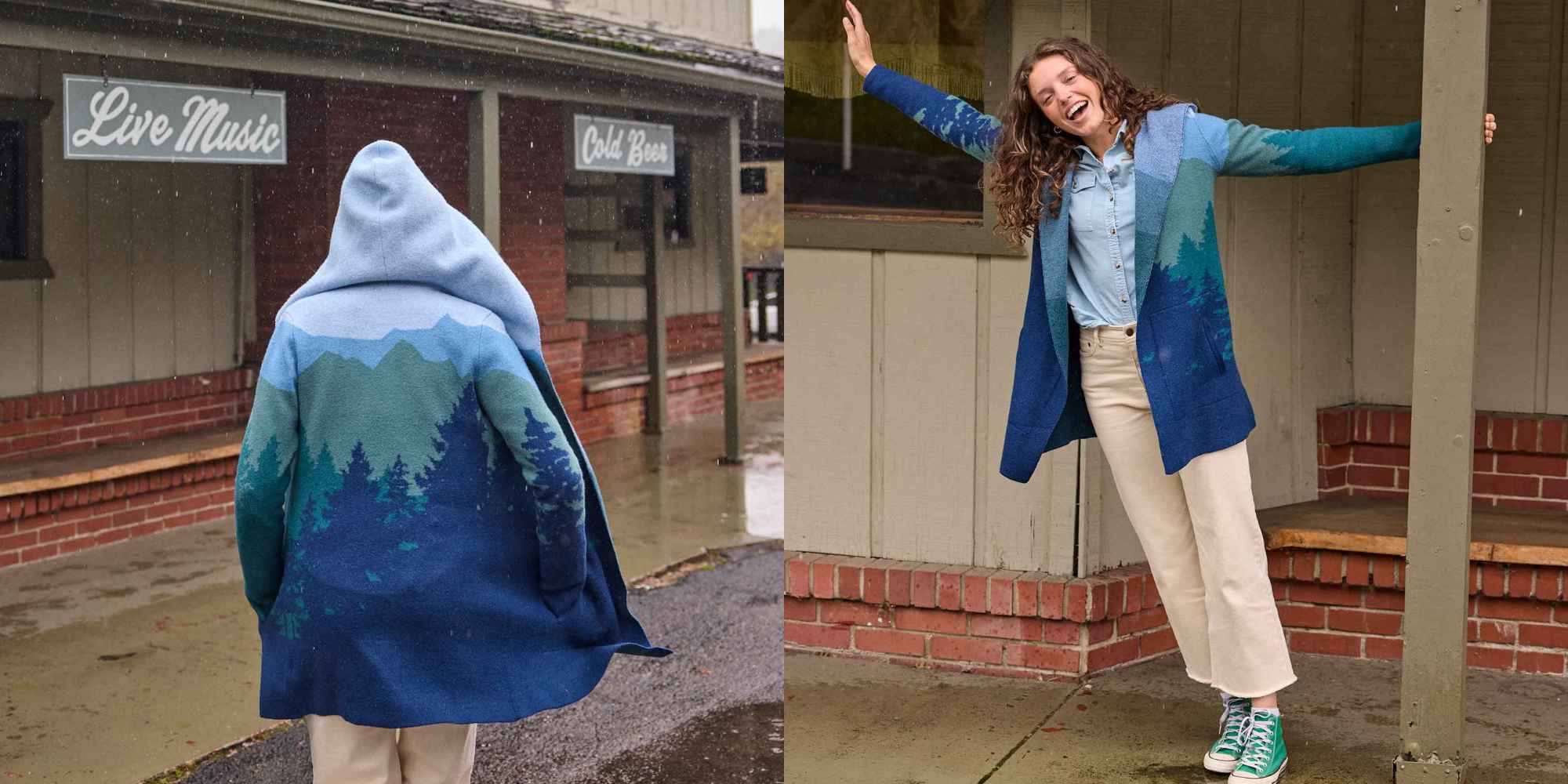
Woven with a beautiful alpine jacquard pattern, this hoodie is made from non-mulesed Merino wool and features pockets at the sides. It’s ideal as a mid-layer under a longer coat when you’re out exploring, or as a cosy item for grabbing a post-walk hot chocolate.
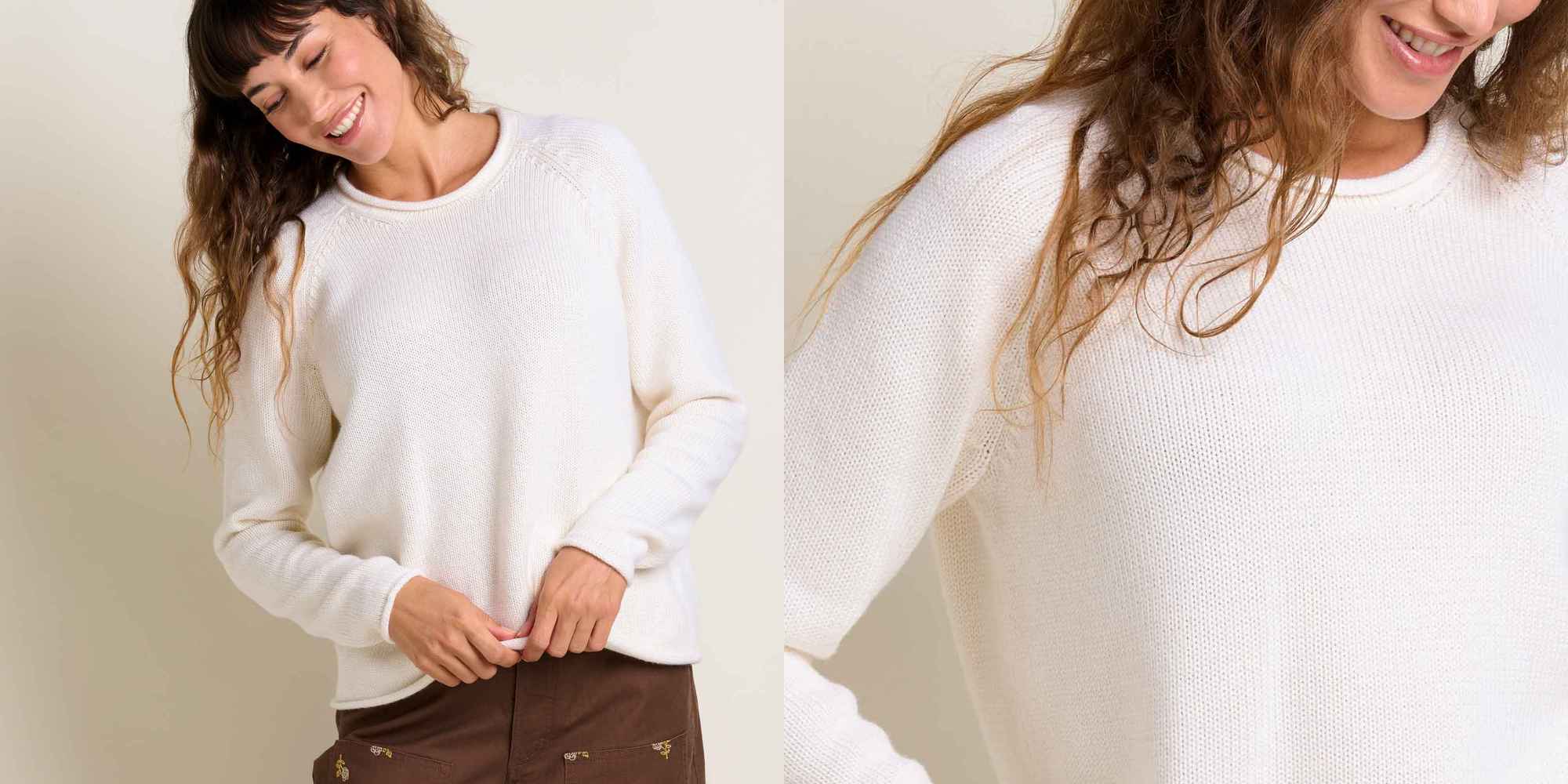
This Alpineglo sweater is a blend of 50% organic cotton and 50% non-mulesed Merino wool, so it’s going to help regulate your temperature in most climates. On top of that, the neutral tone and straight fit make it really versatile—you’ll be reaching for it on the regular.
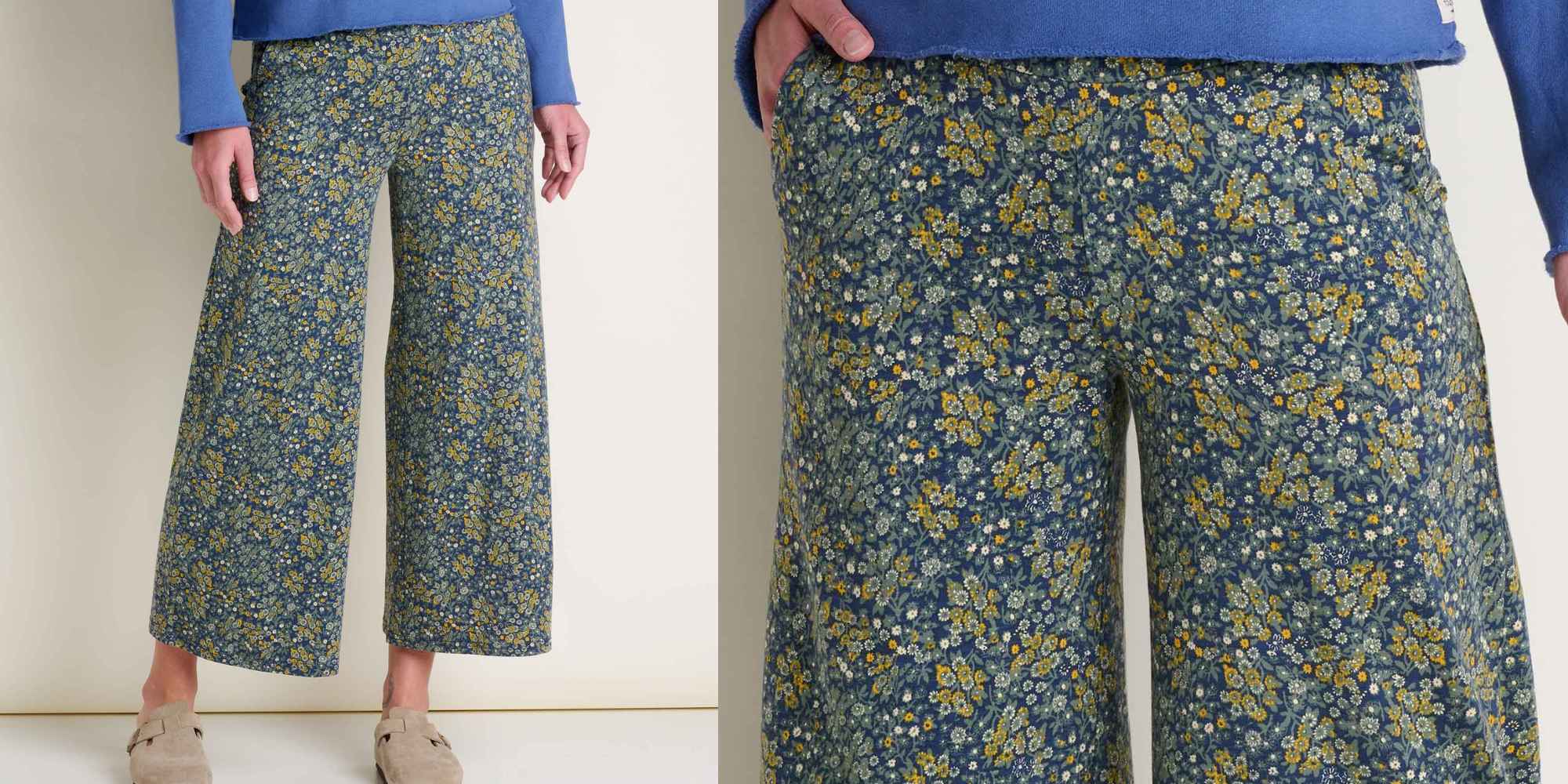
Toad&Co calls these cropped trousers “sweatpant comfortable, going-out presentable”, which makes sense, given they’re made with organic cotton and Tencel Lyocell for softness and have a comfortable wide waistband, not to mention a pretty floral pattern.
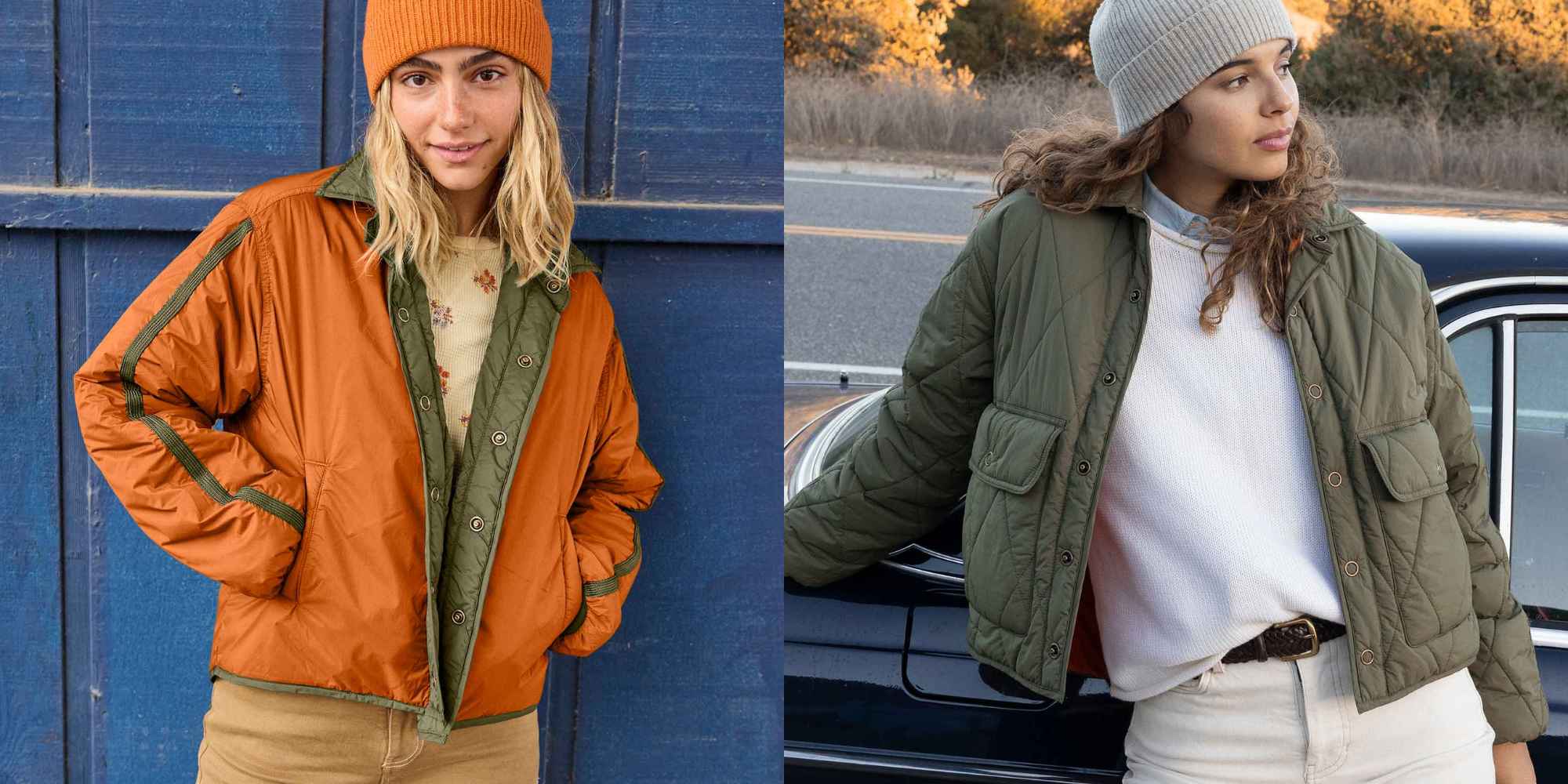
This Nomader jacket is reversible, packable, and water-resistant. In other words, it’s the ideal item to take with you for outdoor adventures. It’s made from recycled nylon and lightly quilted for warmth.
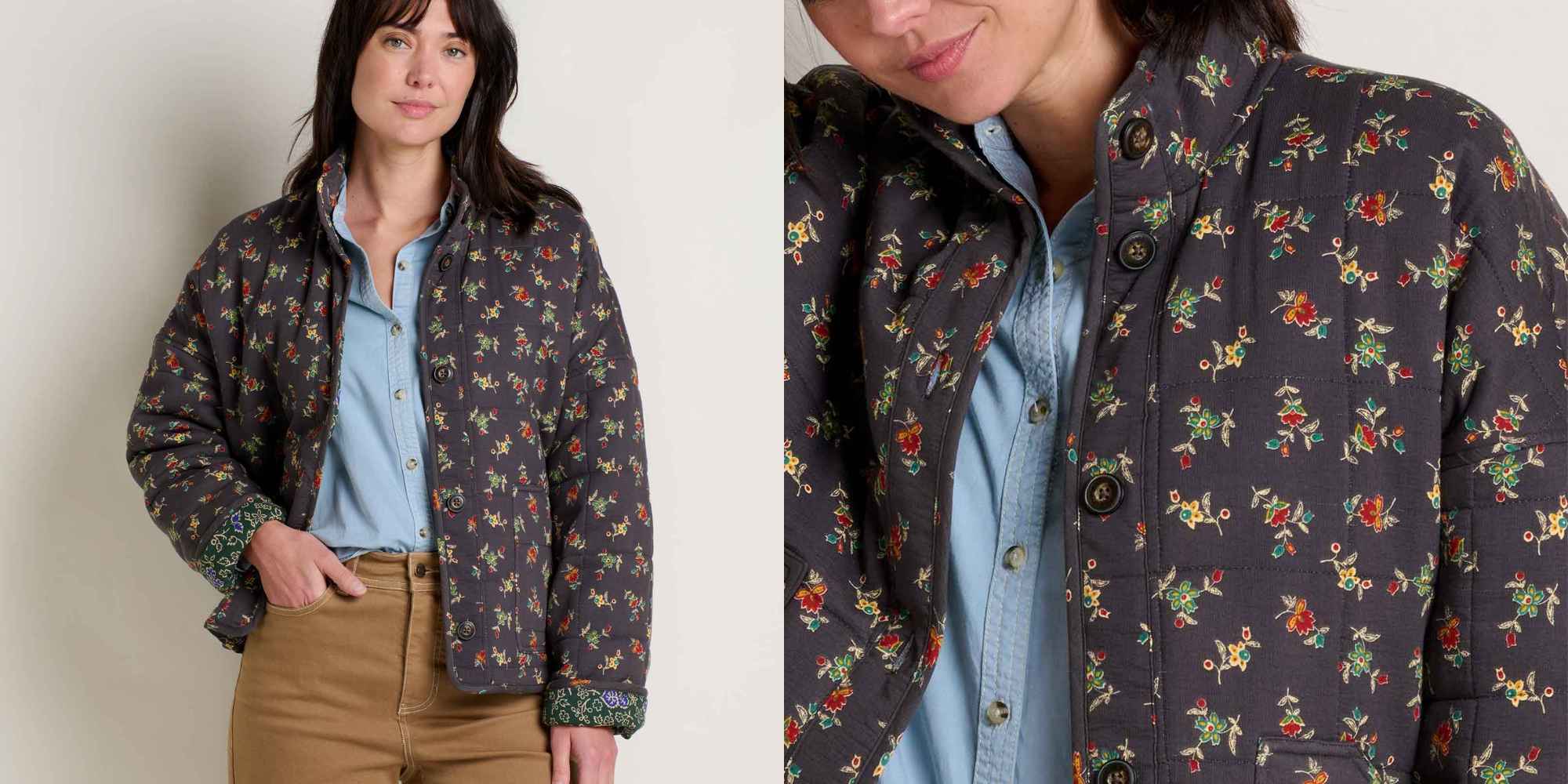
Toad&Co picked the crepe-like organic cotton for this jacket so that you could fold it away in a bag and have it still look presentable when you pull it out. It’s also packed with recycled polyester padding for extra warmth.
 Balsam Cutoff TrousersThese Balsam Trousers are made with a tiny bit of stretch and a special waistband for comfort, so they’ll flex with you and feel good all the time. The neutral brown colour also goes with so many options.
Balsam Cutoff TrousersThese Balsam Trousers are made with a tiny bit of stretch and a special waistband for comfort, so they’ll flex with you and feel good all the time. The neutral brown colour also goes with so many options.These Balsam Trousers are made with a tiny bit of stretch and a special waistband for comfort, so they’ll flex with you and feel good all the time. The neutral brown colour also goes with so many options.
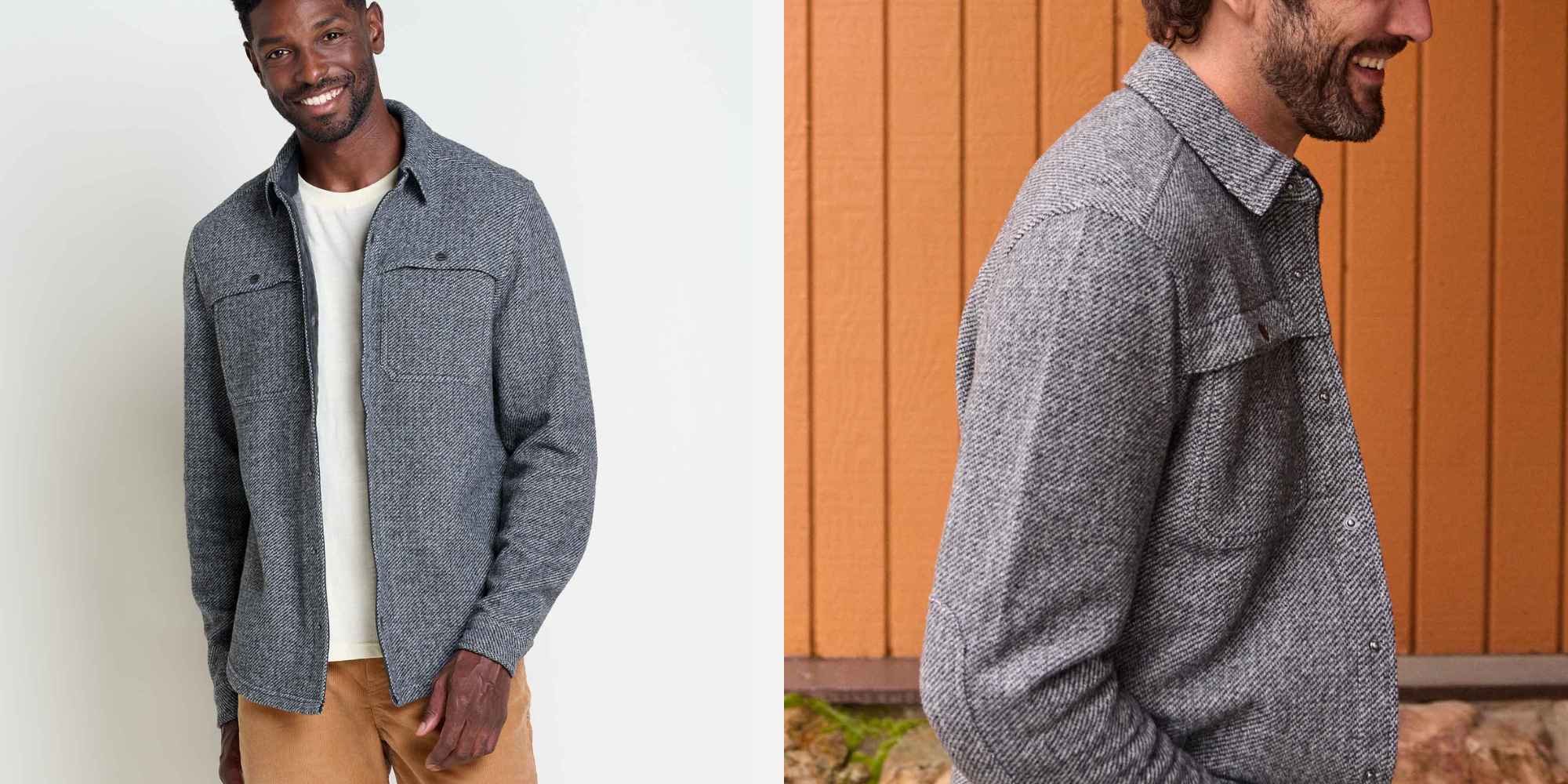
Going from a walk to dinner? From the office to drinks? This Kennicott shirt jacket fits the bill for all of the above. The smart twill fabric incorporates recycled Italian wool.

This is Toad&Co’s Re-Form Herringbone: a blend of recycled cotton and polyester that offers a soft drape and an attractive herringbone weave that looks smarter than the average checked shirt.
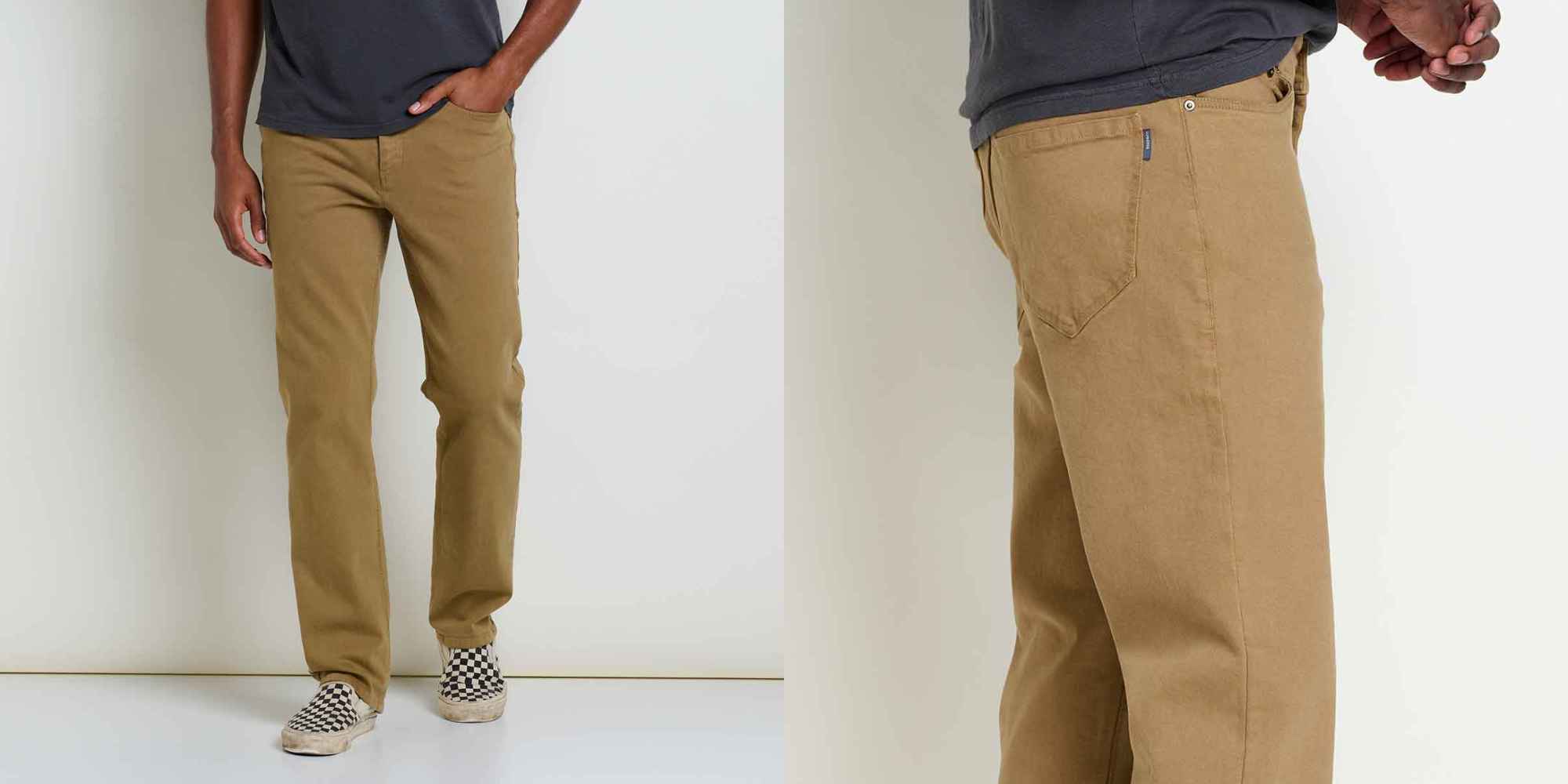
Like the women’s equivalent, these Balsam trousers have a touch of stretch and a comfortable ‘FlexForm’ waistband that mean they’re going to feel comfortable from the get-go—and you won’t need to worry about a belt, either.
Discover more of Toad&Co’s clothes.
The post How Toad&Co’s Clothes Help Everyone Enjoy the Outdoors appeared first on Good On You.
Green Living
50 DIY Christmas Presents Anyone Can Make
Last Updated on November 21, 2025
If you’re on the handmade Christmas kick this year, you’re not alone. So am I!
I’m choosing presence over presents this year and bringing back the 90s Christmas I loved as a kid – simple, crafty, low pressure, and full of small moments that feel meaningful.

If you want to gift thoughtfully, and without breaking the bank, these DIY Christmas presents are for you. There’s something for everyone on this list – whether you prefer easy or complex DIYs.
I’ve included all kinds of DIYs – beauty, cooking, fashion, and practical gifts alike. Best of all? Many of these tutorials are zero waste (or close to it).
what are good homemade Christmas gifts?
Good homemade Christmas gifts include consumable items, like homemade nut butters, vanilla extract, or jams. But not all homemade gifts are edible – you can also make items like bath bombs, candles, body scrubs, beeswax wraps, and so much more.
If you’re extra crafty, you could even make wooden gifts (like shelving or tablet holders), ceramic items (like mugs or jewelry), or knitted/crocheted pieces (like blankets, scarves or hats).
It all depends on your level of skill, time at your disposal, and ingredients/materials you have access to.
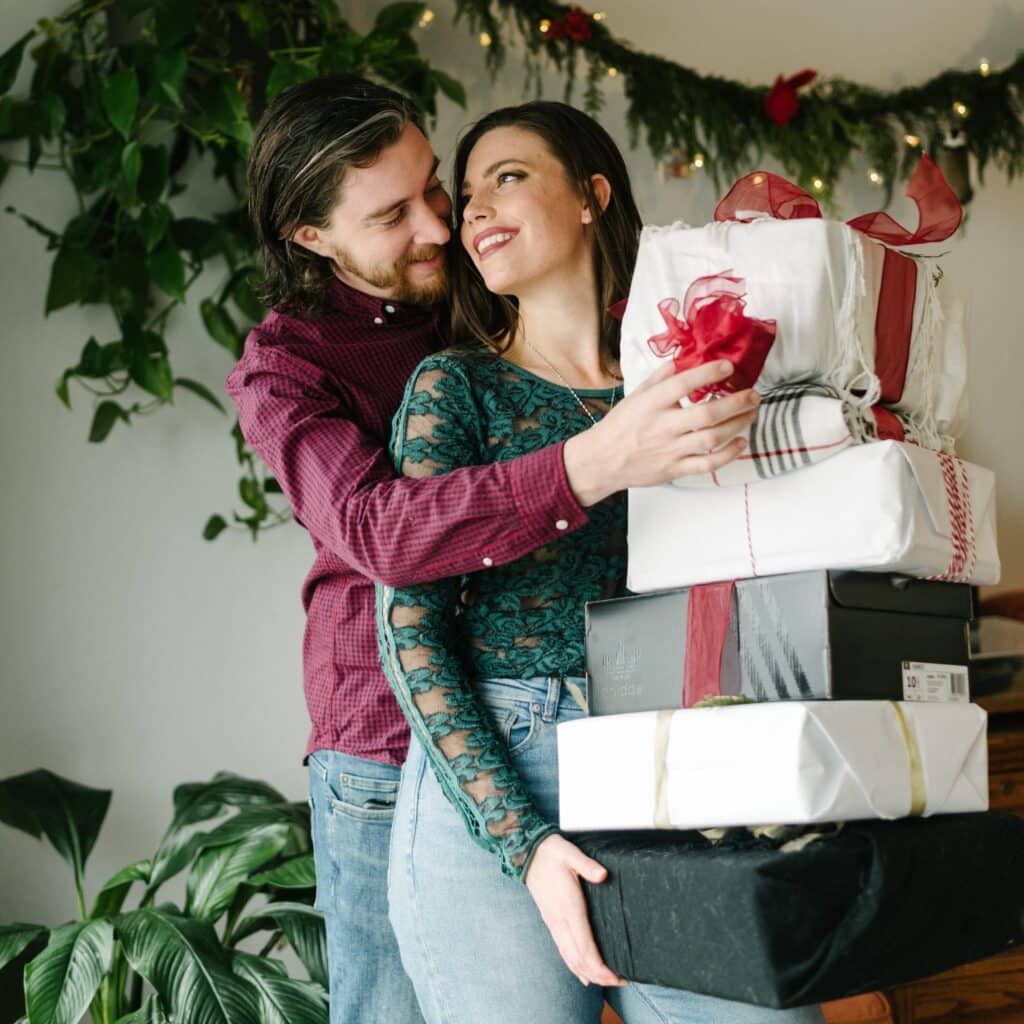
what are good inexpensive Christmas gifts?
Some good inexpensive Christmas gifts are DIY cornstarch ornaments, handmade body or lip scrub, seasoned salt blends, and homemade treats (like these chocolate chip cookies or vegan sugar cookies).
And never forget to hit up your local thrift store – you can find so many great items that would make affordable gift baskets!
Wrapping DIY Christmas gifts also doesn’t have to be expensive. Reusing gift bags and ribbons from last year, upcycling packaging paper, or even repurposing a scarf for furoshiki wrap are all low-waste and affordable!
RELATED: Gift Wrapping: How to Keep It Easy, Eco and Chic
how can I make a last minute gift?
You can make a last minute gift by getting crafty using the materials you have on hand!
For example, if you have a cardboard box, why not try making an upcycled cardboard dollhouse, vehicle, or pirate ship for a child? For adults, a DIY storage container or a shoe rack works.
One of my fav last minute gifts is scented bath salts in an upcycled glass jar – just a little Epsom salt and essential oil blends will do the trick!
Here’s my list of DIY Christmas gifts – something for everyone and every skill level.

- Bath salts
- DIY makeup like mascara/eyeliner, or lip to cheek
- Bath bombs
- Lip scrub
- Lip balm
- Face mask
- Body lotion
- Natural perfume
- Dry shampoo
- Shampoo bar
- Body soap
- Deodorant
- Rose water toner
- Hand-poured coconut/soy/beeswax candles
- Simmer pot in a jar
- Cookie, brownie, soup mix or hot cocoa mix in a jar
- Handmade seasoning blends
- Vanilla extract
- Vegan caramels or plant-based butter wrapped in compostable parchment paper
- Herb or citrus infused olive oil
- Peanut butter + jam
- Beeswax wraps
- Apple or pumpkin butter
- Sourdough or no-knead artisan bread
- Finished embroidery hoops
- Embroidered pillows, tote bags, clothes or cloth napkins
- Sewn cotton rounds
- Knitted scarf, hat, gloves, sweater, or blanket
- Hand warmers
- Quilt blanet, quilted coat or quilted wallet
- Tie dyed secondhand silk scarves, clothing or sheets
- Hand painted or drawn artwork
- Air dry clay paint palette
- DIY wooden frame for paintings or print photos
- Handmade ceramics (mugs, chawan, chasen holder, vase, spoon rest, etc.)
- Woodworked items (birdhouse, shelving, bookcase, wall guitar mount)
- Carving wooden bowls by hand
- Natural branch coasters
- Plant propagations in one of these DIY planters
- Seed balls using native seeds
- Handwoven baskets or bowls
- Macrame produce bag
- Macrame plant hanger
- Fabric paper mache bowls
- Upcycled paper earring jewelry
- Clay earrings
- Handmade plush toys
- Felt ‘food’ toys
- Wooden toys (like vehicles, blocks, or dollhouses)
- Knit or crocheted baby clothes
What do you think of these DIY Christmas presents? Let me know in the comments!
The post 50 DIY Christmas Presents Anyone Can Make appeared first on Going Zero Waste.
Green Living
8 Best Non Toxic Rugs For a Sustainable Home
Last Updated on November 6, 2025
Did you know most rugs are made from polyester, aka plastic? Arguably, a good chunk of our furniture and home decor is nowadays.
And lets not forget – rugs can get a lot of foot traffic. If it’s made from polyester, chances are those plastic fibers are going to shed and get onto us. Or worse, in us.

Some of the links in this post are affiliate links; for more information please see my disclosure policy.
Microplastics have been found in human feces, blood, and even placentas. And according to a study from Stanford University, those who had microplastics in their plaque had a higher risk of heart attack, stroke and death than those who didn’t.
On top of this, 5 billion pounds of rugs go to waste each year – that’s 2% of total US landfill. And if they’re made from plastic? They won’t biodegrade.
It’s more important than ever to reduce our exposure to microfibers where we can. Which is why I’ve rounded up the best non toxic rugs on the market.
what is the least toxic rug?
The least toxic rug will have sustainable materials and use no harsh chemicals (like PFAs) in their production.
Here’s what to look for when purchasing a non-toxic rug:
- Sustainable materials, such as organic cotton, jute, sisal or wool
- Low-waste packaging + delivery
- Natural, non-synthetic dyes
- Third-party certifications like OEKO-TEK, Fair Trade, GOTs
- Easy to spot-clean or machine wash
- Available in various styles, patterns + colors to suit your needs
do all rugs have PFAS?
According to Department of Toxic Substances Control (DTSC), only four samples of 201 carpets and rugs were found to contain more than 100 parts per million in their fibers, indicating PFAS were intentionally added to the products.
However, while PFAs may not be a huge concern for rugs, microplastic pollution is, specifically if your carpet is synthetic. Your best bet is to check the material your rug is made from and choose natural fibers whenever possible.
what is the best non-toxic rug for nursery?
The best non-toxic rug for a nursery would be made from natural materials like wool and organic cotton (which are soft on baby’s skin).
I recommend also checking for natural latex for the rug backing and underlay pads. Brands on this list that offer kid-friendly sizes and patterns include Lorena Canals, Nestig, Quince, and Loomy (more on each below).
what brand of rugs are non-toxic?
The brands of rugs that are non-toxic are listed below. I’ve gone ahead and highlighted some of my favorite features of each brand, but it isn’t an exhaustive list. Be sure to check out their websites for more information.

1. hook and loom
- Various rug sizes, shapes + patterns
- Made from GOTs certified organic cotton, recycled cotton + wool
- No dyes or harmful chemicals
- No latex
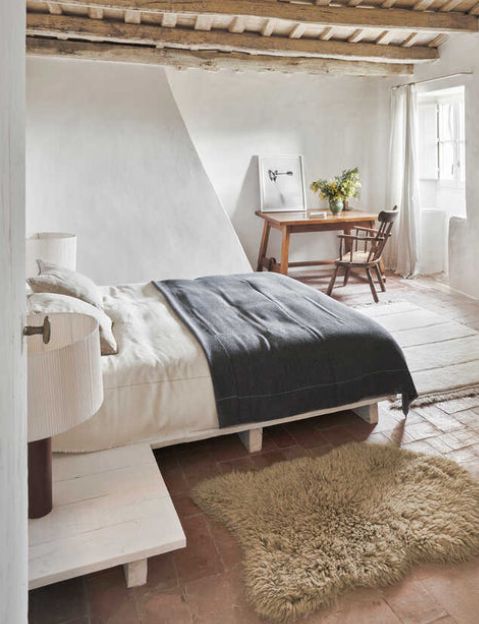
2. lorena canals
- Various rug sizes, shapes + patterns
- Handmade by artisans using recycled materials like organic cotton + wool
- Nontoxic dyes
- Make your own option
- Machine washable
- Rugcycled line made from recycled materials in their own factory
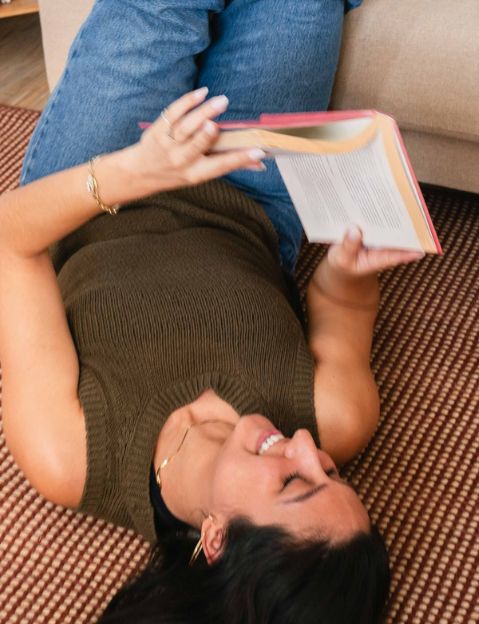
3. sabai
- Field rug
- Woven using wool + jute
- Available in 3 varying sizes
- Rug pad add-on available for reduced movement
- Certified B Corporation

4. quince
- Various sizes + patterns, best known for vintage-inspired looks
- Made from natural materials like wool, jute, + cotton
- Handcrafted by artisans in India
- Transparent pricing practices
- Compostable poly bags + recycled plastic mailers

5. west elm
- Rugs for every area of the home, in varying sizes
- Made from wool, jute, hemp, cotton, TENCEL + recycled materials
- Handspun by skilled artisans in India
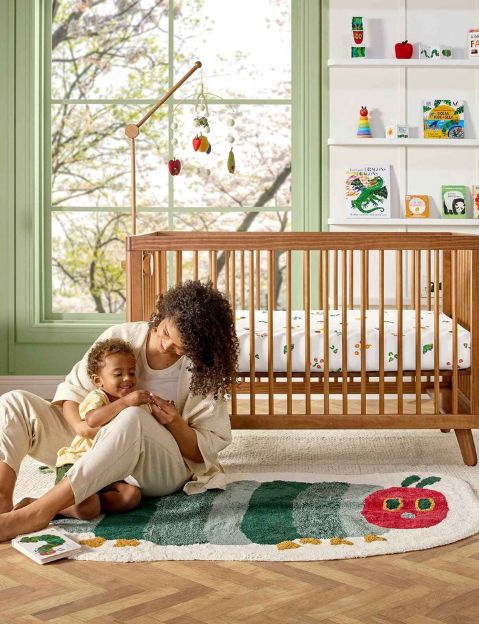
6. nestig
- Area + washable rugs made with fun shapes/designs for babies + kids
- Washable rugs made with organic cotton + nontoxic dyes
- Area rugs made with cotton + each colored element crafted from recycled cotton
- Handmade in Brazil

7. cold picnic
- Various rug shapes + sizes, abstract patterns + bold colors
- Made with wool, bamboo silk, cotton, hemp, + deadstock materials
- Designed in a Brooklyn studio, handmade by artisans in India
- Committed to reducing packaging waste where possible
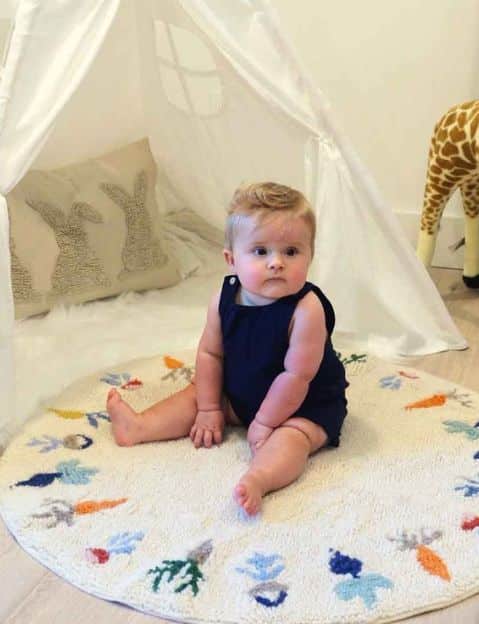
8. loomy
- Various rug sizes, shapes + patterns
- Made from banana silk, hemp, jute, recycled fiber, viscose, or wool
- Any colored yarn dyed using low-impact techniques
- Handcrafted by indigenous artisans
So what do you think of these non toxic, sustainable rugs? Let me know in the comments!
The post 8 Best Non Toxic Rugs For a Sustainable Home appeared first on Going Zero Waste.
-
Climate Change4 months ago
Guest post: Why China is still building new coal – and when it might stop
-
Greenhouse Gases4 months ago
Guest post: Why China is still building new coal – and when it might stop
-
Climate Change2 years ago
Spanish-language misinformation on renewable energy spreads online, report shows
-

 Greenhouse Gases2 years ago
Greenhouse Gases2 years ago嘉宾来稿:满足中国增长的用电需求 光伏加储能“比新建煤电更实惠”
-
Climate Change Videos2 years ago
The toxic gas flares fuelling Nigeria’s climate change – BBC News
-

 Climate Change2 years ago
Climate Change2 years ago嘉宾来稿:满足中国增长的用电需求 光伏加储能“比新建煤电更实惠”
-

 Carbon Footprint2 years ago
Carbon Footprint2 years agoUS SEC’s Climate Disclosure Rules Spur Renewed Interest in Carbon Credits
-
Climate Change2 years ago
Why airlines are perfect targets for anti-greenwashing legal action



